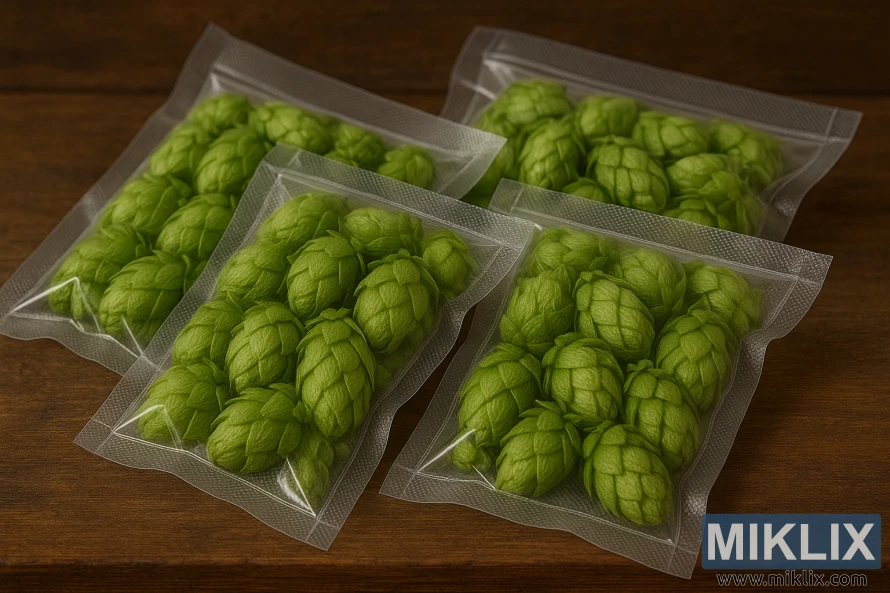Image: Vacuum-sealed fresh hops for brewing
Published: July 19, 2025 at 8:47:40 PM UTC
Last updated: September 27, 2025 at 12:45:42 PM UTC
Four vacuum-sealed bags of vibrant green hop cones on rustic wood, highlighting freshness and proper storage for homebrewing.
On a richly grained wooden surface that exudes warmth and rustic charm, four vacuum-sealed bags of fresh hop cones are arranged with precision and care. The wood beneath them, marked by subtle imperfections and natural texture, sets the tone for a scene that feels both artisanal and grounded in tradition. Each bag is made of transparent plastic with a distinctive diamond-patterned texture, a design that not only reinforces the seal but also adds a tactile quality to the visual composition. Through the clear material, the hop cones are fully visible—vibrant green, plump, and intricately layered with bracts that curl and fold like miniature leaves. Their structure is unmistakably organic, each cone a tiny marvel of nature’s engineering, packed with the oils and acids that give beer its signature bitterness and aroma.
The vacuum-sealing process has compressed the hops just enough to preserve their shape while eliminating excess air, a crucial step in maintaining their freshness and potency. This method of storage is especially important for homebrewers and craft beer enthusiasts who rely on high-quality ingredients to achieve nuanced flavors in their brews. The bags appear almost clinical in their efficiency, yet the contents within are anything but sterile—they’re alive with potential, waiting to be unleashed in the boil kettle or dry-hopped into a fermenter. The contrast between the utilitarian packaging and the organic complexity of the hops creates a visual tension that speaks to the intersection of science and craft in modern brewing.
Soft, natural lighting bathes the scene, casting gentle highlights on the glossy surfaces of the bags and illuminating the vivid green of the hop cones. The interplay of light and shadow enhances the depth of the image, drawing attention to the fine details of the hops—the tiny lupulin glands nestled within the cones, the delicate veins running through each bract, and the subtle variations in color from lime to forest green. These visual cues suggest not only freshness but also the diversity of hop varieties, each with its own flavor profile and brewing application. Whether destined for a citrus-forward IPA or a floral pale ale, these hops are clearly of high quality, meticulously handled and stored with intention.
The overall composition evokes a sense of readiness and anticipation. It’s easy to imagine a brewer reaching for one of these bags, slicing it open with practiced hands, and inhaling the pungent, resinous aroma that escapes—a scent that signals the beginning of a new batch, a new experiment, a new expression of creativity. The rustic wooden surface beneath the bags reinforces the handcrafted nature of the process, suggesting a workspace where tradition meets innovation. This isn’t a sterile lab or a commercial facility—it’s a place where brewing is personal, where each ingredient is chosen with care, and where the final product reflects the brewer’s passion and skill.
In this quiet moment captured by the image, the hops rest in their sealed cocoons, preserved and protected, yet brimming with potential. They are more than just ingredients—they are the soul of the beer, the essence of its character, and the bridge between nature and craft. The scene invites the viewer to appreciate the beauty of preparation, the importance of detail, and the quiet satisfaction of knowing that everything is in place for something truly special to begin.
The image is related to: Hops in Homebrewed Beer: Introduction for Beginners

